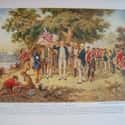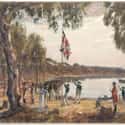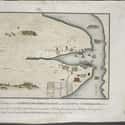-
(#1) England Believed Convicts Were Part Of A 'Criminal Class' And Should Be Removed From The Country
From the years 1750-1900, England underwent changes to its punishment system. Before that time, punishments largely focused on shame and humiliation. Methods such as the stocks and whipping were the norm within England. Over time, however, much of the public increasingly considered those punishments to be barbaric and inhumane. Public opinion on appropriate consequences shifted, and the country had to find new ways to deal with its lawbreakers.
Thus the concept of transporting guilty parties out of the country rose in popularity. England believed all convicts were part of a "criminal class." By removing lawbreakers from the country, officials assumed they were chipping away at this defective group and thereby decreasing crime rates across the country.
-

(#2) Transporting Convicts To New Countries Allowed England To Build Up Overseas Colonies
Although transporting convicts out of the country allowed England to rid its population of the so-called "criminal class," it also served another purpose. By sending convicts to newly established overseas colonies, England expanded its realm of control without sacrificing members of its law-abiding citizenry.
Creating new settlements demanded hard work. Convicts provided sorely needed labor for British colonies that allowed overseas communities to grow and thrive. It was a win-win scenario for England - it rid itself of supposedly harmful individuals while still employing its convicts as valuable resources necessary to expand the English empire.
-

(#3) Convicts Were Originally Sent To America, But The American Revolution Interrupted The Process
Initially, England transported its convicts to America. It's estimated that around 2,000 were sent to the nine American settlements per year, totaling roughly 50,000 convicts transported across the Atlantic Ocean. The convicts committed a wide variety of misdeeds, ranging from political offenses to abductions.
While sending convicts to America was a fairly efficient system for English officials, it was interrupted by the American Revolution. After the US formally gained independence in 1783, England could no longer send its felons to the newly sovereign country.
-
(#4) Captain James Cook Claimed Australia As A British Colony In 1770
The major conflict of the American Revolution started in 1775, but England had already moved to expand its rule beyond the North American colonies. In 1770, Captain James Cook's voyage on the ship Endeavour established the first contact between the British Empire and Australia.
Cook landed in Botany Bay on the east coast of Australia, an area now known as New South Wales. He immediately claimed the country for the English Crown, bringing a new piece of land under British control.
-
(#5) Captain Arthur Phillip Planned To Establish The First Convict Settlement In Botany Bay In 1788
England needed a new location to send its convicts, and Australia provided the perfect solution. In addition, the new country offered a convenient base for British ships in the Pacific Ocean. Much like the American colonies, the Australian settlements offered the opportunity to expand British rule while simultaneously continuing its transportation-dependent punishment system.
In 1788, Captain Arthur Phillip of the Royal Navy set out to establish the first convict settlement in Botany Bay. When he arrived, however, he found the area unsuitable for habitation. They moved to Port Jackson, an area that's now part of the famous Sydney Harbor. Finding the area much more agreeable, Phillip settled into his role as governor of the first Australian colony.
-

(#6) Eleven British Ships Made Up The First Fleet
Eleven British ships made up the first fleet that brought new settlers to Port Jackson. Six of the ships were convict transports, three were store ships, and two were naval escorts.
In all, the fleet brought 736 convicts and 1,000 total settlers to Australia. The voyage took eight long months before the colonists reached their new home.
-
(#7) Little Was Known About Australia At The Time, So Settling There Was Especially Risky
When Phillip landed in Australia, hardly anything was known about the new land. Colonizers had little idea what they would find in terms of food or terrain. They were unaware of the attitude and quantity of the indigenous people. In fact, they weren't even certain of the climate in their new home.
When it came to the convicts, the lack of knowledge was considered a positive. British officials believed fear of the unknown would stop convicts from committing more wrongs in their new home. However, in terms of establishing a colony, the lack of knowledge meant convicts and free men had to work together to breed success from their new settlement.
-
(#8) The First Settlement Provided The Same Opportunities For Convicts And Free Men
Phillip recognized the many challenges associated with creating a successful colony on the other side of the world. He realized the success of his settlement demanded the tireless efforts of all men involved, not just the free men. With that mission in mind, he sought to reform his convict charges, rather than simply disciplining them.
The Port Jackson colony struggled to survive at the start. Many of the settlers were unskilled in farming. Their lack of expertise combined with an unfamiliar climate led to failed crops and a lack of food to satisfy all the settlers. However, Phillip insisted that convicts and free men get the same rations, no matter how much or how little there was at the time. In addition, he gifted land to convicts he deemed deserving, giving them a chance to truly start over in the new world. By valuing the success of his convicts as much as that of any other settler, Phillip ensured his colony survived.
-
(#9) The Colony Was Less Like A Prison And More Like A Town
Phillip's egalitarian outlook changed the landscape of the first penal colony. While the Port Jackson settlement was meant to be a type of prison set away from British soil, it more closely resembled a harmonious British town. As the colony found its footing in the 1790s, convicts and free men lived comfortably together.
Convicts were not locked away or relegated to a specific part of the town. Instead, they were allowed to live in their own cottages where they could build families and create a comfortable home. When their sentence was officially served, they could even receive 30 acres of land to call their own, where they could work and build whatever they wanted.
With time, the soldiers gave up their strict military ways and integrated with the public. They moved away from their military quarters and built their own homes within the community, trying their hand at different trades and establishing a life outside of service to the English Crown. Although later penal colonies treated convicts harshly, the first settlement gave people an opportunity to start fresh in a new land with few ties to their past offenses.
-
(#10) 160,000 Convicts Were Transported To Penal Colonies Around Australia
From the first penal settlement in 1788 to the abolishment of convict transportation in 1868, around 160,000 convicts were transferred from England to Australia. After the success of Port Jackson, convict settlements were established across the country and shipments of prisoners became a regular occurrence. Another convict colony was established at Sullivans Cove in the northern part of the island. Convicts first arrived there in 1804, and a regular influx of lawbreakers to this colony began in 1818.
As convicts became regular settlers in the new land, several settlements were established as a place of secondary punishment. If a convict committed a new offense while in Australia, they were transported again to these particular locations for further punishment. These secondary settlements included Norfolk Island, Macquarie Harbour, Port Macquarie, and Newcastle.
Certain convict establishments focused more intensely on punishment, while others emphasized reformation. Wherever convicts ended up, however, most settlements offered an opportunity for freedom and normality. After serving their sentences, people could live a life of independence on new land with plenty of opportunities to make money. Reformation was possible in most cases, and many convicts went on to live completely normal lives.
-
(#11) Australia Attracted Migration From Other Free Settlers
While Australia was known primarily as a penal colony, many free settlers were attracted to the new continent. New colonists could easily gain their own land, allowing them to make a living that might not have been feasible in England.
In 1831, Western Australia became the second colony of free settlers, though migrants had been making their way over from European countries for quite some time. South Australia was colonized in 1836, followed by Victoria in 1851, Tasmania in 1856, and Queensland in 1859. Many of the new settlers made their living by raising sheep and cattle. They settled largely on the coasts, leaving the dangerous and inhospitable bush alone.
-
(#12) 1840 Was The Beginning Of The End Of Convict Transportation
As Australia gained more settlers and an increased sense of independent rule, conflict arose regarding convict transportation. Many settlers didn't believe in transportation and disputed the idea that their tax dollars be used for the process. At the same time, England's opinion on punishment shifted yet again. It stopped believing in the ultimate power of transportation and grew uncomfortable with the way many convicts were treated when assigned to private employers.
To end the maltreatment of convicts, England abolished convict transportation to private employers in 1840. That choice essentially ended convict transportation altogether, though it was officially eliminated in most Australian states in 1852. During that time, Western Australian colonists instructed the government to send convicts to their settlement. The process continued for 16 more years, until convict transportation ended across Australia in 1868.
-
(#13) The Australian Gold Rush Led To A Population Boom
Migration to Australia surged in the 1850s when gold was discovered in Victoria. At that time, gold seekers around the world poured into the country, boosting Australia's population and economy in the process.
The Australian population quadrupled during that time, and the country's exports expanded immensely. By 1891, the country was a lead exporter in wool, mutton, dairy products, and wheat. In addition, the population expanded from 430,000 in 1851 to 3 million in 1891.
-

(#14) Most Australian Colonies Were Largely Self-Governing
Unlike prior British settlements, most Australian colonies were largely self-governing beginning in the mid-19th century. However, the colonies still had to pay taxes to the British Empire, including the maintenance of penal colonies.
Australia was also still under the legislative power of the British Parliament throughout the 1800s. While there were moments of tension between England and the various Australian colonies, most issues were ironed out with time, leading to a generally friendly relationship between the two countries.
-
(#15) Australian Colonies United In 1901 And The Commonwealth Of Australia Was Established
Australian colonies were largely self-governing because interests across the colonies differed immensely. Each settlement had different priorities, leading to general distrust among the colonists. Between 1860 and 1900, the colonies barely interacted with each other. However, the desire for a united federation grew over time, and in 1901 the colonies finally banded together into one nation - the Commonwealth of Australia.
Under this new system, the colonies transformed into states united under one federal government. The Commonwealth government was in charge of defense, immigration, customs, marriage, and external affairs. Beyond that, each state had power to make its own laws.
-
(#16) The Statute Of Westminster Established Australia As An Autonomous Community Within The British Empire
Although Australia established itself as one nation with a federal government, it was still a dominion of the British Empire. In 1931, the Statute of Westminster provided some clarity for both nations. Under this statute, Australia was established as an independent nation equal to Britain with a common allegiance to the Crown. In other words, Australia was granted full autonomy as a sovereign nation, with no need to abide by British laws now or in the future.
Australia remains a member of the Commonwealth today. In this way, the country maintains ties to Britain while still maintaining its independence.
New Random Displays Display All By Ranking
About This Tool
Australia is now a developed country, but more than 200 years ago, it was still barren land, and even regarded as an island for the penal colony by the United Kingdom. Australia is not a natural place of the penal colony. The British deliberately created a large number of criminals in the late 18th century and forcibly sent them to Australia, allowing those criminals to use their labor to atone for their crimes and help Britain develop new territories.
Australia was originally taken by the British as the penal colony to replace North America and temporarily turned into a large overseas prison. The random tool explained 16 facts about the history of Australia as England's penal colony.
Our data comes from Ranker, If you want to participate in the ranking of items displayed on this page, please click here.






















